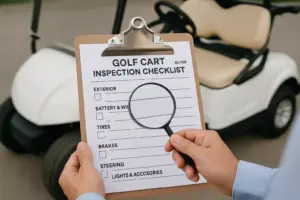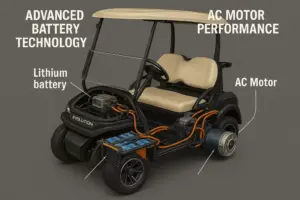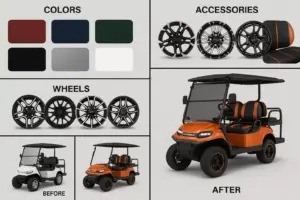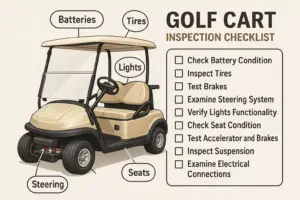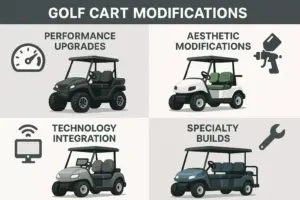5 Things You MUST Check Before Buying a Used Golf Cart
Picture this: You’re ready to cruise around your neighborhood, zip through the golf course, or transport tools around your property. A used golf cart seems like the perfect solution – affordable, practical, and ready to go. But before you hand over your hard-earned money, one wrong decision could leave you with expensive repairs, safety hazards, or a cart that barely runs. Smart buyers know that a few minutes of inspection can save thousands of dollars and countless headaches.
Whether you’re a first-time buyer or looking to upgrade your current ride, understanding what to examine before purchasing a used golf cart is crucial for making a wise investment.
Key Takeaways

- Battery condition and age are the most critical factors, as replacement can cost $800-$2,000
- Tire wear patterns reveal important information about alignment, suspension, and overall cart maintenance
- Brake system functionality is essential for safety and may require expensive repairs if neglected
- Body and frame integrity affects both safety and resale value, with rust being a major red flag
- Electrical and charging systems should be thoroughly tested to avoid costly future repairs
1. Battery Health and Performance 🔋
The battery system is the heart of any electric golf cart and represents the largest potential expense after your initial purchase. A complete battery replacement can cost anywhere from $800 to $2,000, making this inspection absolutely critical.
What to Check:
Battery Age and Type
- Look for manufacturing dates on battery labels
- Most golf cart batteries last 4-6 years with proper maintenance
- Ask for maintenance records showing regular watering and charging
Physical Condition
- Inspect for corrosion around terminals (white or green buildup)
- Check for cracks, bulging, or leaking in battery cases
- Examine cable connections for fraying or damage
Performance Testing
- Request a full charge test – the cart should hold charge for several hours of use
- Test the cart’s speed and acceleration on both flat ground and inclines
- Listen for unusual sounds during operation
Red Flags to Avoid:
⚠️ Batteries that are more than 5 years old without recent replacement
⚠️ Heavy corrosion that cannot be easily cleaned
⚠️ Seller reluctance to demonstrate a full charge cycle
⚠️ Significant loss of power on hills or after short use
Pro Tip: “Always ask to see the cart perform after sitting unused for 24 hours. A healthy battery system should start immediately and maintain consistent power output.” – Golf Cart Technician with 15+ years experience
2. Tire Condition and Alignment 🛞
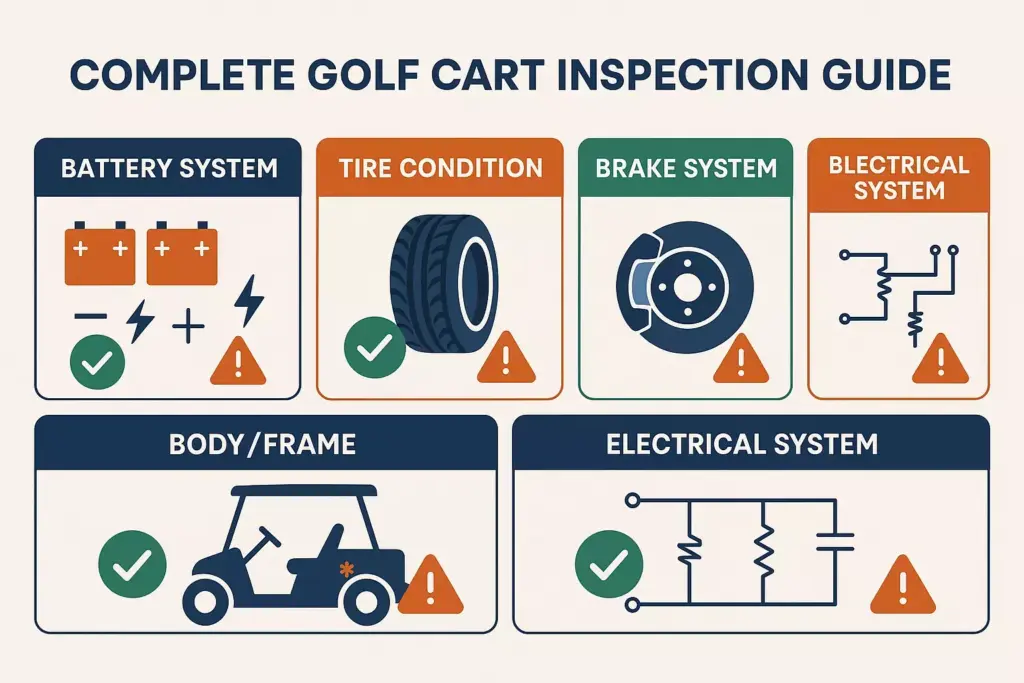
Tires tell a story about how the golf cart has been used, maintained, and whether there are underlying mechanical issues that could cost you significantly down the road.
Inspection Checklist:
Tread Depth and Wear Patterns
- Measure tread depth using a penny test
- Look for even wear across all four tires
- Uneven wear indicates alignment issues, suspension problems, or improper inflation
Sidewall Integrity
- Check for cracks, bulges, or dry rot
- Examine the age code on tire sidewalls (tires older than 6 years should be replaced)
- Look for punctures or plugs that might indicate frequent repairs
Alignment and Suspension
- Test drive the cart in a straight line – it should track straight without pulling
- Listen for unusual noises when turning or going over bumps
- Check that all wheels sit flush and parallel
Cost Considerations:
| Tire Type | Price Range (Set of 4) | Lifespan |
|---|---|---|
| Standard Golf Cart | $200-$400 | 3-5 years |
| All-Terrain | $300-$600 | 4-6 years |
| Low-Profile/Custom | $400-$800 | 2-4 years |
Warning Signs:
- Excessive wear on inside or outside edges
- Cupping or scalloping patterns
- Significant difference in tread depth between tires
- Visible steel belts or fabric showing through
3. Brake System Safety and Function 🛑
Safety should never be compromised, and the brake system is your primary protection against accidents. Many used golf cart buyers overlook this critical component, leading to dangerous situations and expensive repairs.
Essential Brake Tests:
Mechanical Brake Systems
- Test brake pedal feel – should be firm, not spongy
- Check for adequate stopping distance at various speeds
- Listen for grinding, squealing, or unusual noises
- Inspect brake cables for fraying or stretching
Regenerative Braking (Electric Carts)
- Verify that releasing the accelerator engages regenerative braking
- Test that the cart comes to a complete stop smoothly
- Check that brake lights function properly
Physical Inspection Points
- Examine brake pads or shoes for remaining material
- Look for brake fluid leaks (hydraulic systems)
- Check brake drum or rotor condition for scoring or damage
- Verify parking brake holds the cart on an incline
Maintenance Red Flags:
🚨 Immediate Concerns:
- Brake pedal goes to the floor
- Cart takes excessive distance to stop
- Pulling to one side during braking
- Grinding or metal-on-metal sounds
🔧 Repair Indicators:
- Spongy or inconsistent pedal feel
- Brake warning lights (if equipped)
- Visible fluid leaks under the cart
- Parking brake doesn’t hold on slopes
4. Body and Frame Structural Integrity 🏗️
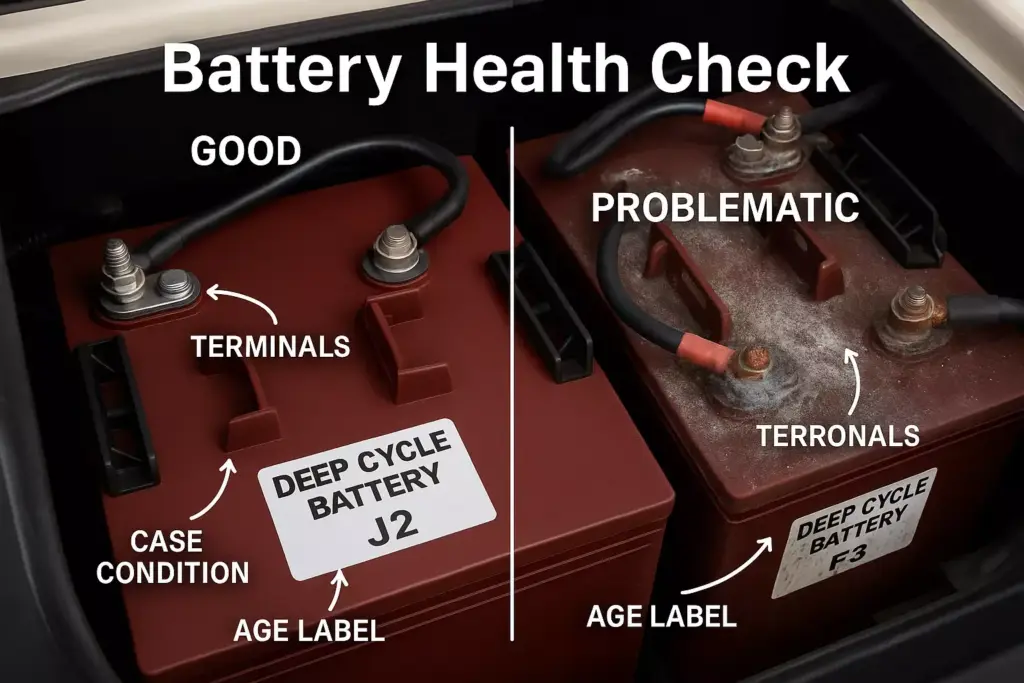
The golf cart’s body and frame provide the foundation for everything else. Structural damage can be expensive to repair and may indicate the cart has been in an accident or subjected to abuse.
Frame Inspection Process:
Rust and Corrosion Assessment
- Check all metal surfaces, especially joints and welds
- Pay special attention to areas where water might collect
- Surface rust is manageable, but structural rust is a deal-breaker
- Examine the undercarriage for hidden damage
Body Panel Evaluation
- Look for dents, cracks, or misaligned panels
- Check that doors (if equipped) open and close properly
- Verify that the roof and windshield are secure
- Inspect seat mounting points for stability
Accident Damage Indicators
- Mismatched paint or obvious touch-up work
- Bent or twisted frame components
- Gaps between body panels that seem uneven
- Welding repairs that look unprofessional
Structural Concerns by Material:
Steel Frames:
- More susceptible to rust but generally stronger
- Check for rust at stress points and joints
- Look for previous welding repairs
Aluminum Frames:
- Corrosion-resistant but can develop stress cracks
- Examine for hairline cracks around mounting points
- Check for galvanic corrosion where different metals meet
Expert Insight: “A golf cart with significant frame damage is rarely worth repairing. The cost of proper structural work often exceeds the cart’s value, and safety can never be guaranteed after major frame repairs.”
5. Electrical and Charging System Verification ⚡
The electrical system controls everything from propulsion to lights, and electrical problems can be among the most expensive and frustrating to diagnose and repair.
Comprehensive Electrical Testing:
Charging System Performance
- Test the onboard charger with a full charge cycle
- Verify that charging indicators function correctly
- Check that the charger shuts off automatically when complete
- Examine charging port for damage or corrosion
Control System Functionality
- Test forward and reverse operation smoothly
- Verify speed control responds appropriately
- Check that all safety interlocks work (seat sensor, brake switch)
- Test any additional features (lights, horn, turn signals)
Wiring and Connections
- Inspect visible wiring for damage, melting, or amateur repairs
- Check that all connections are tight and corrosion-free
- Look for aftermarket modifications that might affect reliability
- Verify that fuses and circuit breakers are properly rated
Common Electrical Issues:
| Problem | Symptoms | Typical Repair Cost |
|---|---|---|
| Faulty Charger | Won’t charge, overcharging | $200-$500 |
| Controller Issues | Jerky acceleration, no power | $300-$800 |
| Wiring Problems | Intermittent operation | $100-$400 |
| Safety Switch Failure | Won’t start, unexpected stopping | $50-$200 |
Testing Protocol:
- Cold start test – Cart should start immediately
- Load test – Performance shouldn’t degrade under load
- Accessory test – All lights and features should work
- Charging test – Complete charge cycle observation
Additional Considerations for Smart Buyers
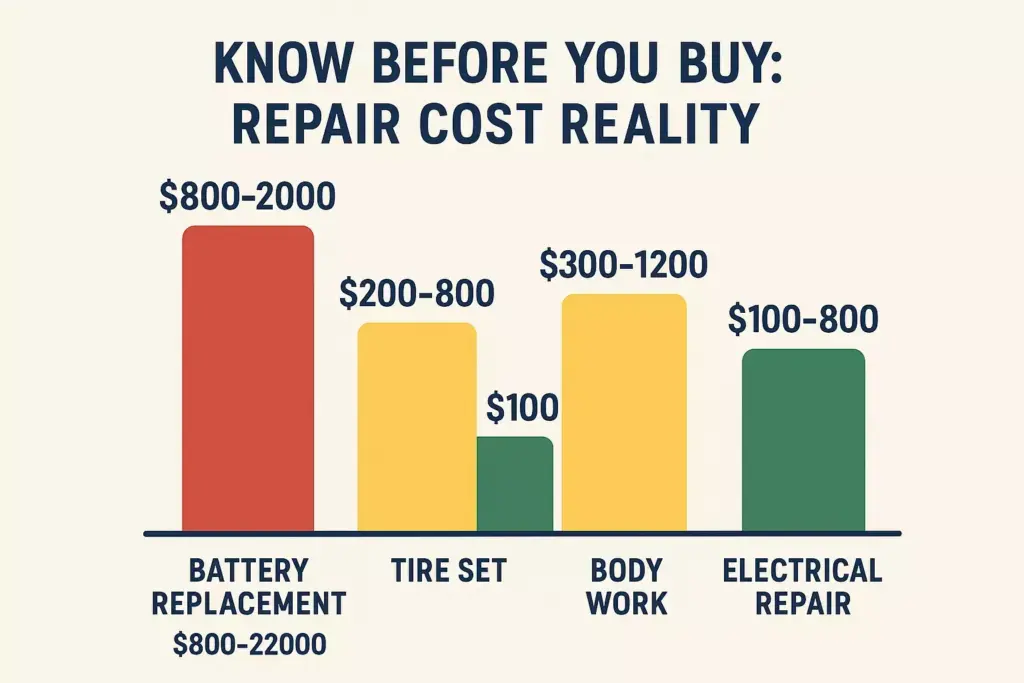
Documentation and History 📋
Essential Paperwork:
- Maintenance records showing regular service
- Previous repair invoices indicating major work
- Owner’s manual and warranty information
- Title or registration (where required)
Age and Model Research 🔍
Factors to Investigate:
- Manufacturer reputation for reliability and parts availability
- Model year features and known issues
- Availability and cost of replacement parts
- Local dealer support and service options
Price Negotiation Strategy 💰
Leverage Points:
- Documented issues found during inspection
- Comparable market prices for similar carts
- Immediate repair needs and their costs
- Seasonal demand fluctuations
Making Your Final Decision
After completing these five critical inspections, you should have a clear picture of the golf cart’s condition and any potential issues. Remember that every used cart will have some wear, but understanding what you’re buying allows you to negotiate appropriately and budget for future maintenance.
When to Walk Away:
- Major structural damage or extensive rust
- Battery system requiring immediate replacement
- Brake system safety concerns
- Electrical problems that are difficult to diagnose
- Seller unwilling to allow thorough inspection
When It’s a Good Buy:
- Minor cosmetic issues with solid mechanical condition
- Recent maintenance records and responsible ownership
- Fair pricing that accounts for any needed repairs
- All safety systems functioning properly
Conclusion
Purchasing a used golf cart doesn’t have to be a gamble. By systematically checking these five critical areas – battery health, tire condition, brake functionality, structural integrity, and electrical systems – you can make an informed decision that saves money and ensures years of reliable service.
Take action today: Before you visit any seller, print this checklist and bring a flashlight, multimeter (if available), and a knowledgeable friend. Don’t rush the inspection process, and remember that walking away from a problematic cart is often the smartest financial decision you can make.
The right used golf cart will provide years of enjoyment and utility. With these inspection guidelines, you’re equipped to find that perfect cart while avoiding costly mistakes that plague unprepared buyers.
🔍 Interactive Golf Cart Inspection Checklist
Check off each item as you inspect the golf cart


